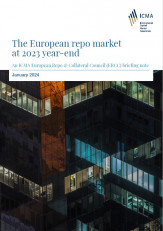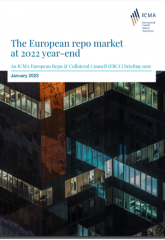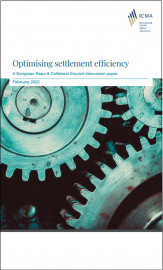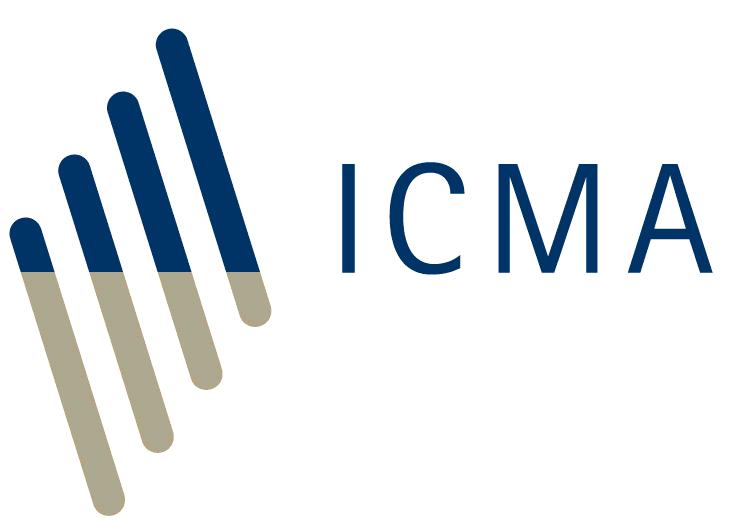ICMA has produced a series of reports, briefings and white papers on various topical issues, highlighting their relation to, and impact on, the European repo market. These are available below.
 ICMA ERCC publishes its analysis of the repo market at 2024 year-end
ICMA ERCC publishes its analysis of the repo market at 2024 year-end
ICMA's European Repo and Collateral Committee (ERCC) has published its annual analysis of how the repo market performed over the recent year-end: The European repo market at 2024 year-end.
Calendar year-end has become a major focal point for repo markets, associated with thin liquidity and heightened rate volatility, and working with its European Repo and Collateral Council (ERCC), ICMA has conducted its assessment of market performance over this period since 2016. The legacy of this particularly stressed turn is still felt today in terms of how and when market participants manage their anticipated year-end funding needs.
The report looks not only at the Euro government repo market, but also those for GBP, USD, and JPY.
The latest report describes how 2024 year-end was, in many respects, different to previous year-ends. As usual, focus on the so-called “turn” began in October, with term and forward trades beginning to price in liquidity premium for December 31 to January 2 (a two-day turn). Unlike recent years, particularly in the case of EUR, the markets began pricing repo rates at a significant premium to benchmark rates, rather than the usual deep discount. This was observed over the September quarter-end, when repo rates spiked higher, and was largely seen as a return to normalisation, with reduced excess liquidity and increased bond issuance tilting the demand-supply dynamic. At the same time, there was growing concern about the increased pressure on the largest G-SIB banks as a result of the soaring stock market, particularly following the November US election result, which was increasing the demand for prime brokerage balance sheet to fund swelling hedge fund longs, and likely to be at the expense of repo funding capacity for fixed income.
However, as we moved into December the pressure began to abate, and rates began to move closer to normal levels. This was partly as many firms had already locked in much of their year-end funding, but also as it became clearer that there was ample liquidity in the market. A number of other factors helped, including a change in market position in government bond markets, as well as the sell-off in the equity markets following the December FOMC.
While much of the discourse over recent years has been on demand-supply imbalances in the repo market at year-end, with the banking system flooded with excess reserves and the market facing collateral scarcity, as ICMA’s annual analysis has shown, the main driver of the year-end effect is in fact balance sheet scarcity; which is much more difficult to predict.
 ICMA ERCC publishes its analysis of how the repo market performed over the 2023 year-end
ICMA ERCC publishes its analysis of how the repo market performed over the 2023 year-end
The ICMA European Repo and Collateral Committee has published its annual analysis of how the repo market performed over the recent year-end: The European repo market at 2023 year-end.
Year-end repo market pricing and liquidity are generally a focus of market attention, with the euro market proving itself particularly vulnerable to significant dislocations in recent years. ICMA’s European Repo and Collateral Committee (ERCC) has published a review of repo market performance and conditions over the “turn” of the year since the wholly unexpected and somewhat unprecedented extreme price moves observed in the euro repo market at 2016 year-end.
Following an expensive, but relatively calm, 2022 year-end and a year of central bank ‘normalization’ of monetary policy, the 2023 turn was never expected to be as problematic as previous year-ends, even with it being four calendar days in duration. In many ways, the interest was largely to see how ‘normal’ the end of 2023 would be.
The report showed that Compared to previous year-ends, the 2023 turn for the euro repo market proved to be relatively unexceptional. While the market began pricing in around 250bp premium for German GC and 150bp premium for French GC back in October, this continued to erode as we got closer to the end of the year, ultimately trading around 60bp and 40bp rich respectively.
Non-core euro GC was even less spectacular, tightening by around 15bp.
Similarly, the dispersion in rates for specials was relatively contained and largely in line with the moves in GC.
This relative calmness is attributed to a number of factors, namely: a reduction in the level of excess reserves; an increase in the supply of government bonds; general deleveraging and a lack of positioning by hedge funds; the collapse in the EUR-USD FX basis; and reduced pressure on bank intermediation arising from various regulatory reporting requirements.
The report also provides commentary and analysis of year-end for the sterling, dollar, and yen repo markets.
 ICMA ERCC publishes its analysis of how the repo market performed over the 2022 year-end
ICMA ERCC publishes its analysis of how the repo market performed over the 2022 year-end
The ICMA European Repo and Collateral Committee has published its annual analysis of how the repo market performed over the recent year-end: The repo market at 2022 year-end. The 2022 euro “turn” was being discussed as early as the summer, with underlying concerns related to the ongoing situation of excess liquidity in the banking system, scarcity in some collateral (notably German government bonds), and seasonal curbs on repo market-making capacity. By late September, the implied repo rate for German collateral over the three-day turn was somewhere between ESTR-800bp and ESTR-1,000bp, prompting many stakeholders to raise concerns publicly as well as with the ECB. The report shows that pricing over year-end improved significantly in the weeks leading up to the date, and once we got to December 28, German collateral (both general collateral and specific collateral) averaged around ESTR-350bp (with some specials trading wider than ESTR-400bp), French collateral around ESTR-290bp, and Italian collateral around ESTR-195bp. Perhaps the biggest surprise was Spanish collateral, which had become trickier to source going into December, and which averaged around ESTR-300bp over the turn. There are several potential factors that helped to contain the extent of the year-end repo market price dislocation. These include the October announcement of the Deutsche Finanzagentur that it would make available on repo an additional €54bn of German government bonds, across 18 ISINs, the increase in the ECB’s borrowing facility against cash from €150bn to €250bn, and the large repayment of the Targeted Long-Term Refinancing Operation on 21 December The report also provides commentary and analysis of year-end for the sterling, dollar, and yen repo markets.
 Optimising settlement efficiency - An ERCC discussion paper
Optimising settlement efficiency - An ERCC discussion paper
In the wake of the go-live of CSDR settlement discipline, the ERCC is releasing this discussion paper to focus attention on a number of key opportunities to strengthen settlement efficiency in Europe, which are complementary to the CSDR measures. While ICMA and the ERCC have been supportive of cash penalties, we believe that these should be supplemented by a broader industry effort to support settlement efficiency, focusing on existing tools and processes. Over the past year a number of key issues have been identified and explored further with members in a series of cross-industry workshops, including the shaping of settlement instructions, partial settlement and auto-partialling, as well as automatic borrowing and lending. This paper recaps the key take aways from those discussions and aims to serve as a basis for a broader debate on settlement efficiency with other industry stakeholders, central banks and regulators. .
Many of the opportunities discussed in the paper are already covered in in existing best practices, in particular the ERCC Guide to Best Practice in the European Repo Market. Alongside the paper, the ERCC has therefore published a compilation of best practice recommendations , extracted from the Guide and endorsed by the ERCC Committee at its latest meeting highlighting the commitment by member firms to follow these best practices recognising the benefits for the wider market.
The European repo market at 2021 year-end
The ICMA European Repo and Collateral Council (ERCC) has published a report on the performance of the European repo market at year-end 2021, focused on the euro, sterling, US dollar and Japanese yen markets and based on market data and accounts provided by market participants (both sell-side and buy-side). This is the 6th in the series of annual reports, following the analysis of dislocations in the euro denominated repo market at the end of 2016.
The general view of market participants is that the year-end for the euro repo market was relatively orderly from an operational perspective, particularly for core sovereign collateral, where, along with significant pre-positioning, central bank lending programmes are likely to have played an important role. That said, this was still the most expensive year-end for core repo since 2016, and certainly saw the lowest rates for the most sustained period leading up to any year-end. Meanwhile, non-core repo rates, somewhat unexpectedly, were even tighter than at year end 2016, making this the most expensive turn since the euro was launched. And while the levels of stress experienced at the 2016 year-end were not observed in 2021, some participants have expressed concern at the extreme levels recorded, the relative lack of liquidity, and the fact that participants were pre-positioning actively, and expensively, from as early as October.
 ICMA ERCC consultation on the role of repo in green and sustainable finance: summary report
ICMA ERCC consultation on the role of repo in green and sustainable finance: summary report
ICMA’s European Repo and Collateral Council (ERCC) has published a summary report on the role of repo in green finance, following its consultation to reflect feedback received in response to a market consultation on the role of repo in sustainable finance which took place earlier this year. The consultation paper, issued in April 2021, was intended to serve as a starting point for promoting a broader discussion in the repo community on sustainability, as well as to explore the existing opportunities and potential risks in this area.
The report published today summarises the consultation feedback, highlighting the key themes raised in the 20 responses that have been submitted. Building on the consultation results, ICMA is considering with the ERCC next steps regarding potential guidance on repo and sustainability in close coordination with the Executive Committee of the Green & Social Bond Principles.
Green and sustainable finance: What is the role of the repo market?
The ICMA European Repo and Collateral Council (ERCC) has published a consultation paper on the role of repo in green and sustainable finance, exploring the sustainability aspects of repo and collateral as well as assessing the existing opportunities and potential risks in this area. In particular, the paper looks at the different possible intersections between the repo and collateral market and sustainable finance: 1. Repo with green and sustainable collateral; 2. Repo with green and sustainable cash proceeds and 3. Repo between green and sustainable counterparties.
The paper was published alongside a list of consultation questions and is intended to serve as a starting point for promoting a broader discussion in the repo community on sustainability. It reflects the complexity of the topic and the variety of views.
The results of the consultation will help the ICMA ERCC to identify areas of focus going forward and help to frame future workstreams, if required.
The European repo market at 2020 year-end
The ICMA European repo and Collateral Council (ERCC) has published a report on the performance of the European repo market at year-end 2020, focused on the euro, sterling, US dollar and Japanese yen markets and based on market data and accounts provided by market participants (both sell-side and buy-side). This is the 5th in the series of annual reports, which began with an analysis of the unprecedented dislocations in the euro denominated repo market at the end of 2016.
After the past three relatively uneventful year-ends, concerns about potential year-end dislocations began to build as early as October 2020, following the largely unexpected drop in rates at the September quarter-end. Market participants were wary of a potential collateral squeeze, citing significant excess reserves (which had increased from €1.7 trillion at the end of 2019 to €3.2 trillion by the end of October 2020) and a reduced supply of collateral (euro sovereign issuance less central bank purchases had taken €300 billion of collateral out of the market during 2020). A longer than usual (four-day) turn compounded any unease.
In fact, the general view is that the turn was relatively subdued, with the buy-side looking to execute as much of their funding requirements as early as possible, while the banks went into year-end with more balance sheet than usual to play with. A common concern, however, relates more to conditions over the next twelve months, particularly in the case of the EUR market, given the widening of the PEPP envelope and the prospect of an even smaller EGB collateral pool; more so than the perennial uncertainty related to banks’ balance sheets and dealer capacity. A further consideration for the immediate future is the impact of Brexit on repo market liquidity, as well as for euro denominated derivatives, particularly in light of the migration of the euro equity markets from the UK to the Eurozone on 4 January 2021. The end of the pension fund industry’s exemption for mandatory clearing could also increase demand for euro collateral transformation, an issue currently under discussion with the relevant authorities.
The ICMA ERCC will continue to monitor closely market developments, highlighting potential risks and dislocations to the smooth and orderly function of the market. In doing so, it will remain in close contact with the relevant authorities and regulatory bodies.
Published January 2021
 The European repo market and the COVID-19 crisis
The European repo market and the COVID-19 crisis
This short report reflects on the European repo market during the initial phase of the COVID-19 market turbulence that began in late February and ran until early April. The report looks at market performance over that time, as well as market accessibility, collateral management challenges, settlement efficiency, and the implications for haircuts and collateral maintenance. While primarily focused on the euro sovereign segment of the market, it also reports on the performance of the sterling and USD markets.
The feedback from market participants is that the European repo market, for the most part, has ‘held up well’ during the market turbulence, that peaked in late February/early March. However, this has not been without some strains. In particular, as the demand for repo increased, banks’ capacity to intermediate remained constrained. Meanwhile, the market has had to deal with the disruption of operating remotely, with implications for both the supply of collateral and operational efficiency.
Published April 2020
 ICMA Recommendations for Reporting under SFTR
ICMA Recommendations for Reporting under SFTR
The ERCC has published on 24 February 2020 its guide to reporting under the EU Securities Financing Transactions Regulation (SFTR). The ICMA guide aims to help members interpret the regulatory reporting framework specified by ESMA and sets out complementary best practice recommendations to provide additional clarity and address ambiguities in the official guidance. It is supplemented by a suite of sample reports and an overview of repo life-cycle event reporting, which have both been published today. The documents evolved over the past couple of years as a product of discussions within the ERCC’s SFTR Task Force, benefitting from substantial input provided by members.
- ICMA Recommendations for Reporting under SFTR
- SFTR sample reports
- Overview of repo lifecycle events reporting
These are not static documents and will continue to evolve as we move closer to the reporting go-live date in April and beyond. Please make sure to download the latest version from our SFTR webpage when consulting the guide.
Published February 2020
The European repo market at 2019 year-end
This report focuses on the euro, sterling, and USD markets, and given the significant attention on the USD repo market since September 2019 and in the build-up to year-end, this is the starting point for the 2019 review. The analysis is based on market data and accounts provided by market participants (both sell-side and buy-side).
This is the fourth in the series of annual reports which began with an analysis of the stresses and dislocations witnessed in the euro denominated market at 2016 year-end, which were unprecedented, and caught market participants and authorities off guard. In many respects, the extremities of 2016 were the culmination of a perfect storm of factors, including market positioning, dislocations in the EUR/USD FX basis, an excess of euro cash in the banking system, and a reduction in the intermediation capacity of dealers due to regulatory reporting requirements.
While subsequent year-ends have not been as stretched, they have nonetheless continued to raise concerns among both liquidity providers and market users. What the 2017 and 2018 year-end reports reveal is a change in behaviour, both on the sell-side and buy-side. In the case of dealers, we observe more balance sheet being put to use over the turn (particularly by the non-GSIB community), while asset managers have stepped up preparedness, locking in financing needs early, negotiating balance sheet allocation from their dealers well in advance, or turning to alternative money market instruments to manage their liquidity. This has not, however, prevented significant price moves in both general collateral and specific issues.
In brief, compared to previous year-ends, 2019 was relatively uneventful. As one market participant commented, it was possibly the most subdued year-end of the decade. But the reasons for this are in themselves worthy of analysis and further discussion.
Published January 2020
The European repo market at 2018 year-end
This report documents and analyses repo market behaviour through 2018 year-end.
The repo market at 2018 year-end was more subdued than anticipated. Core Euro GC and specials did come at a premium leading up to the turn but then cheapened significantly into year-end itself. Meanwhile, non-core GC saw scarcely an impact, with only some specials becoming difficult to find. The short-date Gilt repo market tightened slightly, however term spreads widened notably, seemingly caused by the introduction of UK bank ring-fencing. The US treasury repo market, however, was the real surprise, with an unexpected scramble for cash sending rates notably higher.
While the markets, for the most part, were fairly orderly, it is clear that a number of year-end pressures and risks persist. Banks still face pressures to reduce balance sheet, and so their intermediation capacity, in order to comply with a number of entity or jurisdictional specific reporting obligations, including Basel ratios (primarily Leverage Ratio), national bank levies, and the G-SIB capital surcharge. Positioning is also an exacerbating factor, both in terms of bonds/collateral and FX – which is highlighted by the spike in USD rates.
However, since 2016 it would seem as if the market has become more aware of these risks and better prepared in terms of managing its year-end financing and collateral requirements. Locking-in funding early, however, comes at a premium. But, while the extreme levels and dislocations of the 2016 turn have not been repeated since, there is still plenty of quantitative and qualitative evidence to suggest that year-end pressures persist, and that access to repo and lending markets for many firms is impaired.
Published January 2019
 The GFMA and ICMA Repo Market Study: Post-Crisis Reforms and the Evolution of the Repo and Broader SFT Markets
The GFMA and ICMA Repo Market Study: Post-Crisis Reforms and the Evolution of the Repo and Broader SFT Markets
The GFMA and ICMA have jointly published a report, The GFMA and ICMA Repo Market Study: Post-Crisis Reforms and the Evolution of the Repo and Broader SFT Markets, which was prepared with the support of member firms – in particular including 33 survey respondents from repo and collateral desks across Asia, Europe and North America; and 14 member firms providing quantitative impact analysis on SFT minimum haircuts.
The purpose of the report is to provide an analysis and evaluation of the post-crisis assessment of the vulnerabilities in SFT markets, the subsequent regulatory reforms and how these have influenced the way in which SFT markets function. It also highlights practitioners’ views on potential future developments and vulnerabilities. The goal is for this report to provide a comprehensive and fact-based analysis to assist policymakers’ discussions on ways to further assess the coherence and calibration of the post-crisis reforms with regards to their impact on repo and broader SFT markets, which enable the functioning of the global capital markets as well as the broader financial system.
Published December 2018
EMIR REFIT: Incentivizing Post-trade Risk Reduction
- ICMA ERCC, together with ISDA, the EBF and ISLA, whitepaper on benefits of post-trade risk reduction services
- 10 April 2018 press release accompanying the PTRR report
The European repo market at 2017 year-end
The 2016 year-end provided an extreme benchmark by which future year-ends will be assessed, and, in relative terms, the 2017 year-end was mostly orderly. However, balance sheet pressures over the ‘turn’ persisted, and core GC tightened significantly (more than 350bp in the case of German collateral), as did specials (by as much as 600 to 700bp in the case of some French government bonds). Meanwhile, compared to 2016, periphery sovereign markets traded relatively tighter, as did Gilt repo.
This short report uses market data and interviews with market participants (sell-side and buy-side) to provide a brief analysis of the 2017 turn, and the underlying factors that made it expensive and difficult, but not as extreme and disorderly as the previous year.
Published January 2018
ICMA European Credit Repo Market Study
ICMA publishes 'The European Credit Repo Market: The cornerstone of corporate bond market liquidity' which explores and describes the state and evolution of the European corporate bond repo and securities lending market (the ‘credit repo market’). The study builds on ICMA’s previous work with respect to both corporate bond market and repo market evolution and liquidity, and investigates the European credit repo market from the perspective of its role, structure, participants, dynamics, external impacts, challenges, opportunities, and potential evolution, particularly to the extent that this plays a pivotal role in overall corporate bond market liquidity.
Published June 2017
The euro repo market at March 2017 quarter-end
- An update of the ICMA ERCC report 'Closed for business' looking at repo market behaviour over the March 2017 quarter-end.
Closed for business: a post-mortem of the European repo market break-down over the 2016 year-end
- This report, based on available market data and interviews with market participants (including repo market-makers, buy-side firms, and infrastructure providers), attempts to document repo market moves and behaviour in the final week of December of 2016. More specifically it seeks to answer: (i) what happened? (ii) why it happened? and (iii) what possible measures can be taken to avoid future extreme dislocation?
Farewell 2016.... Welcome 2017
- Presentation of the way one ICMA ERCC member firm saw, and may expect to see, things.
- ICMA ERCC report on the trade registration models used by European CCPs for repo transactions - September 2016
ICMA Regulatory Overview on the identification and reporting of SFTs
This paper provides a regulatory overview on the reporting and identification of SFTs and was last updated on 9 August 2016, supplemented by the Impact Analysis slides which was last updated on 8 February 2016.
ICMA and AFME joint report on the lessons learned from T2S wave 1
ICMA and AFME published a joint report on 20 January 2016 on the lessons learned from T2S wave 1.
- ICMA ERC study which looks at how the repo market in Europe is changing in response to regulatory pressures - November 2015
- IFLR article: BANKING & PROJECT FINANCE - REPO REFORM - Hit by a train. By Andy Hill, Director, Market Practice and Regulatory Policy, ICMA - September 2015
Future challenges in repo post-trade processing: Changes, impacts & consequences
- SFT identification and reporting: Regulatory overview paper and impact analysis
- Harmonised template for repo trade matching and affirmation
- ICMA seminar on The Future Challenges in Post-Trade Processing for Repo
ICMA ERC report on the successful migration of the European bond markets to T+2
- Report on the successful migration of the European fixed income markets to T+2 - October 2014
CSDR Mandatory Buy-ins and the treatment of SFTs
- ICMA CSDR Mandatory Buy-in Impact Study - February 2015
- An ICMA-ERC Briefing Note: Covers existing remedies for failing SFTs; SFTs and secondary market liquidity; collateral fluidity; CSDR mandatory buy-ins and SFTs; and the ICMA ERC* position on mandatory buy-ins and SFTs - September 2014
- Collateral is the new cash: the systemic risks of inhibiting collateral fluidity – April 2014
Avoiding Counterproductive Regulation in Capital Markets - October 2013
The impact of the Financial Transaction Tax on the European repo market
- Collateral damage: the impact of the Financial Transaction Tax on the European repo market and its consequences for the financial markets and the real economy - April 2013
- Written in conjunction with the CICF: Collateral Fluidity White Paper – November 2012
-
- Shadow banking and repo - March 2012
- Repo: guilty notwithstanding the evidence? - April 2012
- Haircuts and initial margins in the repo market - February 2012
-
- The interconnectivity of central and commercial bank money in the clearing and settlement of the European repo market - September 2011
European repo market white paper on short-selling and settlement failures and updates
-
- 25 March 2011: Update on reform of market infrastructure in Italy and Greece since the ERC* white paper of 13 July 2010
- Update to July European repo market white paper, 17 December 2010
- European repo market white paper published 13 July 2010
Contacts:
Andy Hill
Managing Director, Head of Market Practice; Secretary to the Secondary Market Practices Committee and also responsible for overseeing repo policy; Member of the ICMA Executive Committee
Direct line: +44 20 7213 0335
Alexander Westphal
Senior Director, Market Practice and Regulatory Policy, secretary to the ICMA European Repo and Collateral Council and Committee (ERCC) and ERCC Operations Group.
Direct line: +44 20 7213 0333







